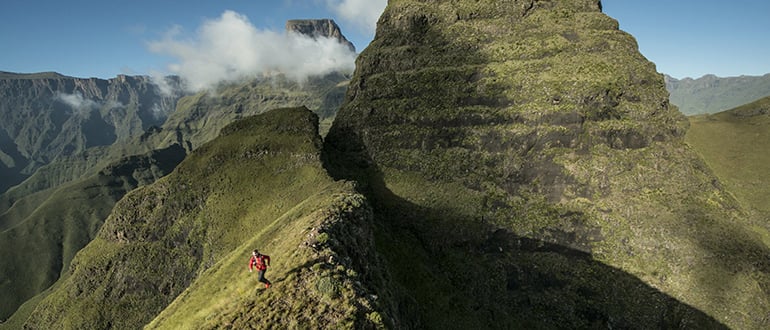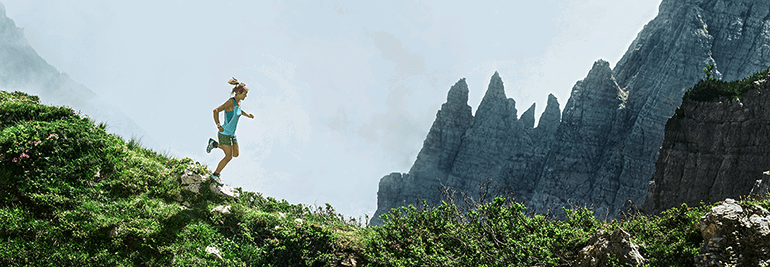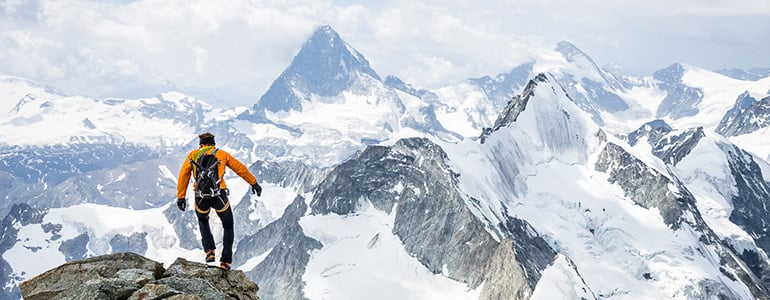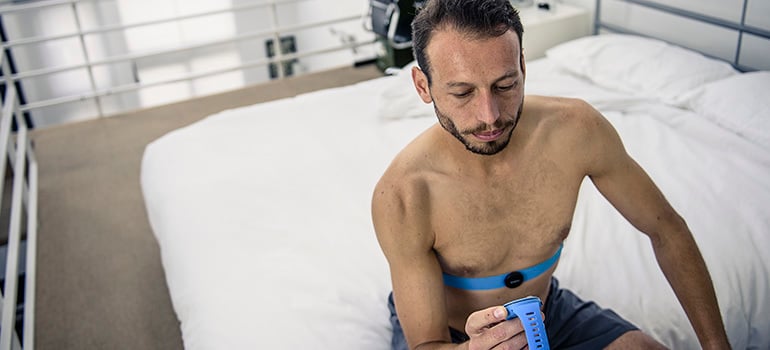

Suunto Blog

How to handle setbacks like a champion
Being an athlete isn’t all glory and endorphin highs. Just ask champion ultra runner Ryan Sandes. He’s had to pull out of three races recently due to catching glandular fever and struggling to recover. Now he’s taking a break from running to allow his body time to fully heal. We caught up with Ryan and asked him a few questions about how he deals with setbacks.
How are you doing after your recent setbacks?I feel pretty low and disappointed now, but I am focusing on switching off from my setback and not overthinking it too much as that just makes it worse. I am putting a plan in place to fix my health and that is all I can do. I have had a crap year racing, but I have had some epic experiences this year, traveled to some awesome places and it is important to be grateful for that!
Check out Ryan's recovery tips for before and after the race!
Ryan enjoys a soak after announcing he's taking a short break from ultra running to recover. © Ryan SandesHow do athletes often react to a setback, whether injury or illness? It is really frustrating and demoralizing at the time. You think back to all the hard training and effort you have put into a specific goal and then all of a sudden that all disappears. I always try to focus on the positives in the situation and remember that a setback is not the end of the world – it’s just a hurdle on the way to reaching my dreams.
Find out how to use the Suunto Ambit3 to help you recover
Are setbacks always a bad thing or can they be helpful in unexpected ways?
I think it’s actually through our setbacks that we learn the most about ourselves and develop as people. It’s easy when everything is going right, but when you have a major setback it really tests you and when you come out the other side, it makes your achievement that much more rewarding. I find after a big setback I am more focused and determined than ever.
Having unstructured fun is important for recovery. © Ryan SandesWhat do athletes often fear most about setbacks and is this fear necessarily true? It’s a common worry that if you can't train you will lose your fitness and not be ready for an upcoming race, but I believe often the body knows best, and the time off from training helps it to fully recover and get strong after all the training. You will often see an athlete come back really strong after an injury because they have taken enough time off.
Read more recovery tips from Suunto's ambassadors!
Setbacks can make you stronger, Ryan says. © Ryan Sandes
If someone gets an injury, they can sometimes get training withdrawal– how do you recommend working with this? Sitting around with an injury is really frustrating and you get 'cabin fever' as you know all your fellow athletes are outside training. It’s important to focus on fully recovering and doing your rehab so you can come back stronger. If you can’t run and are feeling really frustrated then go outside for an easy hike to be outdoors, but don't push yourself otherwise you will just get injured again.
What recovery really means – from a physiology specialist
What to do if you lose your motivation because of a setback?
If you are feeling a real lack of motivation take a complete break and focus on the fun element of your training or just having fun in general. This could be running for fun with no specific time or training goals or even just hanging out with friends and having a laugh. Take your mind off training and the setback to reboot your system and feel inspired again. Don’t take life too seriously and accept that you will have setbacks along the way.
It's important to keep the big picture in mind, Ryan says. © Ryan SandesDo you have a favorite quote about never giving up?
"If one dream dies, dream another dream. If you get knocked down, get back up and go again." - Joel Osteen

24h cycle tour around Mont Blanc
It’s 7000 m of elevation gain and 300 km and ice climbers and alpinists Matthias Scherer and partner Tanja Schmitt aim to cover their Tour Mont Blanc in less than 24 hours.
It’s the highest mountain in the Alps and cycling around the base of Mont Blanc takes most people around five days. Matthias Scherer and Tanja Schmitt aim cycle it on racing bikes in less than 24 hours this Sunday.
© Matthias Scherer
They’ve been climbing mountains and frozen waterfalls for over 15 years together and for them Mont Blanc – with its stunning ice channels and snow covered flanks – is a symbol of their shared passion.“Mont Blanc for me is something like a church,” Matthias says. “When I see it, it reminds me there’s something higher and more important in life to long for than numbers and training.”The unsupported tour will be the ultimate test of their bodies and minds before autumn arrives and their ice-climbing season begins. The most challenging part, however, will be staying focused and fueled.“You have to be extremely concentrated the whole time,” Matthias says. “The descents are very tricky, the roads aren’t always good, as they have holes. “You have to stay fueled if you want to keep a rhythm.”
© Matthias Scherer
They’ll be drinking water every 10 minutes, taking electrolytes every 13 minutes, eating energy blocks every 20 minutes and sandwiches before each long downhill to allow enough rest time for digestion. Another challenge is making sure they don’t push too hard too early on in the tour. “At the beginning of a big tour like this it’s common to be a little bit euphoric and to push too hard,” Matthias explains. To avoid this, they will use their Ambit3 Peak watches to ensure they keep their heart rates at 70 per cent of their maximum. They’ll also use their watches to record their elevation gain and for GPS tracking to navigate the few stages of the tour they’re less familiar with.“It’s going to be a long training day for us, but I don’t expect to be broken,” Matthias says. “I plan to go climbing right away on Monday.”

Emelie Forsberg's power pancake recipe
Training a lot and want to power up? Then try cooking up this recipe for high-energy almond and banana pancakes from skyrunning champion Emelie Forsberg.Eating healthy, nutritious food is essential for recovery after intense training. But it need not be boring! Suunto ambassador Emelie Forsberg spends her days running in the mountains and then making and baking delicious, energy rich food to help her recover.
The morning after a big race, for example, the world and European skyrunning champion likes to enjoy a big plate of healthy pancakes.
"After an ultra, when your body is drained and you've eaten a lot of chocolate or gels, I like to eat fresh and healthy, at least on the first and second day," Emelie says. "But pancakes are my standard breakfast the morning after a race, and yes, I think pancakes can be healthy. Especially my banana pancakes!"
Who could say no to these? © Emelie Forsberg
Emelie Forsberg's power pancake recipe!
Ingredients:
3 organic bananas3 tbsp coconut oil3 eggs1 tbsp honey or 1 tbsp bee pollen ( If you don't have pollen, it doesn't matter, I just like the taste of it)200 ml oat flour100 ml almond flour100 - 200 ml almond/rice/soy milk1 tbsp honey + 1 tbsp pollen1/2 tsp salt1/2 tbsp cinnamon and cardamom if you like that1 tsp baking soda
Method:
Grind the oat and almonds to flour. Or, if you prefer, use bought oat and almond flour. Add all the dry ingredients. Mash the bananas and blend with the eggs, oil and the honey. Add the milk (or if you want the pancakes more solid you skip the milk).
Emelie's favorite toppings:
1. Fresh strawberries, rasberries, blueberries or cloudberries2. Bananas and honey3. Good cheeses4. Whipped cream with jam or fruit

Exploring wrecks in the Gulf of Finland
It’s been a busy summer for the Badewanne diving team. The Finnish group of underwater explorers have dived a number of deep wrecks in the Gulf of Finland from the first and second world wars and also discovered an unnamed wreck from the 19th century. In this team report they give the lowdown on their finds so far: Operating from the Estonian and Finnish side, we have made dives during which history has again revealed itself before our eyes.Near Osmussaar Island, Estonia we visited the wreck of Russian mineship Yenisei, another victim of victorious U26 from summer of 1915. The mighty ironclad rests on the seabed at 45 m listing to port, with the Obuhov cannons in their casemate stations defiantly pointing towards the green light above.
U 479 lies at a depth of 95 m. ©Badewanne.fi
Next we headed out further into central Gulf of Finland and revisited the wreck of WW2 era wreck U 479. She rests on the seabed at 95 m after hitting a mine in the late fall of 1944. Dropping down through the water, we can see that the water is very layered, and eventually pass through the halocline at 75 m. There is a distinct boundary layer where water is optically distorted as we enter the more saline deepwater. Visibility at the wreck is good, and we utilize our short bottom time to shoot video of this uniquely well preserved WW2 U-boat wreck. Continuing our journey through time, we dived another deep wreck, a WW2 “Torpedoboot” T18. It wasn’t a small “motor torpedo boat”, as many would think about, but in German classification it’s a 900 ton small destroyer of “Torpedoboot 37” class. The wreck is broken in the middle, laying at almost 100 m. Visibility is very good, and we obtain a good series of still images before undertaking the ascent, and the subsequent and inevitable almost three hours of decompression.
The Torpedo boat T18. ©badewanne.fiNext we move back to Finnish side, and establish our base on Hanko peninsula at Tvärminne Zoological Station, a scientific facility operated by University of Helsinki. From Tvärminne we again head out to the mouth of Gulf of Finland. We visit the wreck of U26, vanquisher of Pallada and Yenisei before her own fate in the fall of 1915. This wreck is very tricky to dive as it’s in a very busy location on the westbound shipping lane. Cooperation with maritime traffic controllers, Helsinki Traffic and Tallin Traffic is essential for safe and successful diving. We shoot video and stills for our documentary purposes, before we leave the U26 to her rest, which has lasted for 100 years this year.
The wreck of the Yenisei, sunk by U26. ©badewanne.fi Next target is something we don’t know – something that according to sonar images could be even a submarine. However, when we drop through 75 m of water, we arrive at a wreck of a mail ship from the 19thcentury. Her bows are buried in the glacial clay, and deck cabins have suffered from inevitable trawl damage, but it can be clearly seen that this ship has transported mail – and people. Fancy cast-iron lattice in railings, beautifully crafted wooden benches can be seen on upper deck, together with the ships’ wheel still standing, and the engine telegram and compass bowl on the deck. The identity of the ship is yet unknown.
Further out, during a lucky weather break, we again drop down to wreck at 80 m looking for a real “motor torpedo boat”. This turned out to be German Kriegsmarine Schnellboot S106 from the WW2 era, as we hoped. She’s broken in two by a mine explosion, but in very good condition. This is another new discovery, which adds a significant piece into the puzzle of naval warfare in the Gulf of Finland during WW2. After shooting images we again undertake the long ascent towards the green light.
Kriegsmarine Schnellboot S106 ©badewanne.fi These are some impressions from our expedition this summer. However, there are still many weekends left of the diving season. Stay tuned, we may bring you more interesting stuff before the winter closes in! For more info on the Badewanne team, head over to their website.

How were the 82 summits, Ueli Steck?
How many of 82 peaks had you climbed before?
Not sure, but not too many. I had never climbed the easier mountains before.
Climbing Les Droites. © Ueli SteckWhat did the #82Summits project teach you?
That it’s all about motivation. I was surprised how long I could keep going without stopping or having rest days. It’s different to an expedition because I was moving almost everyday. That was great. I was so motivated that even on rest days I went for a run!
What three words would you use to describe #82summits?
Passion. Friendship. Fun.
What were some of the most unforgettable moments of the summer?
There were many great moments. The last one was on Barre des Écrins, in the French Alps. I ran up the wrong valley in the morning. Instead of taking the trail to Glacier Blanc, I went to Glacier Noir. There was a sign I read and I was sure the trail to Glacier Blanc was on the left. It felt strange, but I kept going. I ran for another two hours before reaching the end of the valley. By then it was daylight and I realized I wasn’t where I should be. I checked Google Maps and figured out I was on the wrong side on the mountain. I ran back down and after 3h40 minutes I was back in the valley from where I started my ascent again. So I did a little extra to warm up!
Ueli and wife Nicole on Fiescherhorn. © Ueli Steck
When was the project at its hardest?
Mentally, it was the hardest in the beginning. You start and there are still so many peaks to climb!
You started the project with Michi Wohlleben, but didn’t finish with him. What happened?
Michi crashed his paraglider descending from the Schreckhorn Hut in Switzerland. Afterwards he tried his best, but couldn’t continue.
Aiguille Blanche de Peuterey. © Ueli Steck
How did losing your partner early on change things?
It was a difficult moment. What could I do? I didn’t want to give up so easily. That’s not my personality. I would never forgive myself. So I kept going and it turned out great. It was so much fun to climb with different partners and to do solo climbs. I still have very great memories of climbing with Andreas Steindel, a mountain guide and member of the Swiss Ski Mountaineering Team. Climbing with my best friend and supporter Daniel Mader and, of course, also the summits I climbed with my wife, were all great experiences. I also enjoyed solo climbing some peaks.
How were the cycling stages of the project?
This was something new to me. On the last part down from Massif des Écrins, I really felt the magic of cycling. Going over Col du Galibier, an iconic section on the Tour de France, is a great memory. And after so many kilometres your butt doesn’t hurt anymore!
A rainy day didn't stop Ueli having fun cycling over Col du Galibier. © Ueli Steck
If you had to choose, what were some of your favourite peaks?
1. Red Pillar of Brouillard, on the Brouillard flank of Mont Blanc, in Italy
2. Dent du Geant-Grandes Jorasses Traverse: multiple 4000 m peaks on the border between France and Italy
3. Monte Rosa Traverse: 18 peaks in one day
4. Finsteraarhorn, Switzerland with my wife
5. Aiguille blanche de Peuterey, Mont Blanc massif, Italy with Jonathan Griffith
In some of your Facebook posts you refer to the pioneers who did the first ascents on these peaks. Was there a historical side to your project as well?
It was great to be on all of these routes. Sometimes you think about the people who did the first ascents and you realize that what these guys achieved was just incredible!

Here's what recovery really means
We all know proper recovery is an essential part of any training regime, but what exactly happens in our bodies while we rest, how does it impact our performance and how can new recovery features released to Ambit3 watches support our recovery? To get the answers on the science of recovery, we talked with Tero Myllymäki, who leads the physiological analytics development at Firstbeat Technologies.
Tero, can you talk us through how recovery impacts our performance?
The role of recovery is not only crucial to an athlete’s development, but to overall health and wellness; without sufficient recovery, it is impossible to build one’s endurance and stamina. In sports, the whole exercise philosophy is based on the fact that while exercising, body balance, so called homeostasis, is placed in a state of imbalance which lowers our body’s performance level. By taking the time to rest (referred to as “recovery”), this performance level is gained back, and, thanks to this recovery process, it is possible to gain a higher performance level.
What about the role of a good night’s sleep?
A really important fact in recovery is the need for a good night’s sleep. Sleeping well at night is really crucial to recovery, since it is a repetitive, long period of time, during which all body functions can relax. If recovery is successful, all the stress caused by strenuous exercising, along with other factors in your daily life, is reset at night (while you rest), and the body’s resources are replenished. Body stress and recovery can be compared to batteries: you can only use them or charge them once in a while.
Suunto Ambit3 watch offers two tests for measuring my recovery level, but what are the tests measuring in practise?
Recovery is analyzed by measuring the body’s autonomic regulation balance through heart rate variance. At night, one would expect the parasympathetic (so-called relaxing body function) to be powerful and thorough enough to activate the body’s recovery processes. Recovery measurement tests determine how calm a person’s body is during sleep.
How does this information benefit an athlete?
Monitoring this recovery can make the time used in exercising more efficient, because it is good to know when you can exercise on full speed, and when you should take it more slowly and simply let your body recover. Recovery measurement tests will also tell you when you are training too hard, or when you should work harder, so that an athlete can measure the risk of exercising too hard, or not exercising at all. Recovery monitoring is a learning process for you; it enables an athlete to reflect on how he/she is feeling.
What about muscle pain or flue, will the recovery test recognize these?
Even though the autonomic regulation has regained normal levels, intense or abnormal exercises done by an athlete might cause muscle damage, as well as risk to the overall body energy levels. These situations cannot be monitored via autonomic regulation tests. Weakened muscle level recovery can be seen during the exercise, although you wouldn’t be able to see it in the recovery tests. Instead, the effect of diseases such as fever which affect the overall body regulation system, can be seen in the autonomic regulation activity, and, consequently, from the recovery test data.
Can I analyze my sleep quality with the test?
Sleeping badly, and/or waking up during the night can be regarded as a side-effect of the body refusing to slow down, and the heart’s autonomic regulation and/or parasympathetic regulations are weak. This also lowers the recovery levels. The quality of your sleep is influenced by many different factors, and sometimes it may indicate how a person feels about his/her sleep; other times, it may be a direct result of the electrical impulses in the brain which measure sleep phases. Recovery measurements won’t directly measure these sleep phases, but it can reflect on it by measuring autonomic regulation (how relaxed the body is).
Read more about the features: Tutorial Tuesday: Learn how to use Ambit3's recovery features
Tero Myllymäki, M.Sc., Physiology Research, Firstbeat TechnologiesMr. Myllymäki is responsible for physiological analytics development and research collaboration at Firstbeat. He possesses an academic background, and previously worked as a researcher in several multidisciplinary expert teams, combining physiology, psychology, and technology. His goal is to seek innovative solutions for providing meaningful and actionable feedback on well-being, lifestyle, and performance in daily life. Mr. Myllymäki has a Master’s Degree in exercise physiology from the University of Jyväskylä.
Get to know your recovery status with Ambit3 watchSuunto Ambit3 watch offers two ways to follow your recovery. The quick recovery test and the sleep recovery test both measure your heart rate variability to give you an indication of your recovery status in percent. The higher the percentage, the more recovered you are. The tests require a Bluetooth Smart compatible heart rate sensor that measures heart rate variability (R-R interval), such as Suunto Smart Sensor.
The quick recovery test is performed by wearing the Smart Sensor belt for three minutes and then checking the recovery percentage from the Suunto Ambit3 watch. Alternatively, you can run the sleep recovery test which measures your heart rate variability through the night to give you an accurate indication of your recovery status in the morning when you wake up.














































































